Family of Ester Porges (-> Fred Astaire)
|
 Simon Juda Austerlitz (b. Prague 1797, d. 1864) married Ester Porges
(b. 1804, d. 1859). They lived in Josefove (Prague)
Simon Juda Austerlitz (b. Prague 1797, d. 1864) married Ester Porges
(b. 1804, d. 1859). They lived in Josefove (Prague)
Ester Porges is the daughter of Rabbi Abraham Porges Spiro
 Salomon Stefan Austerlitz (b. Prague 1833,
d. ?)
Salomon Stefan Austerlitz (b. Prague 1833,
d. ?)
The claim that one branch of the Austerlitz family lived here
on the Unterbergsgasse in the old Jewish quarter of Eisenstadt,
Austria seems to be a myth. Astaire's grandfather was said to
have once lived here, but Fred Astaire's parents were Catholic
and Lutheran and he was an Episcopalian all of his adult life.
 Ernst Austerlitz
(b. 1864)
Ernst Austerlitz
(b. 1864)
 Ernst Austerlitz
Ernst Austerlitz
 Otto Austerlitz
(b. 1877)
Otto Austerlitz
(b. 1877)
Fritz's brothers Otto and Ernst remained
in Austria and were soldiers during World War I. Ernst later
lived in Vienna and had a son, also named Ernst, who was killed
in World War II. The elder Ernst worked as a postal official
in the Austrian city of Klagenfurt. Astaire's uncle Otto worked
for the predecessor of Dun and Bradstreet in Austria.
 Friedrich
(Fritz) Emanuel Austerlitz (b. Linz Austria, 08/09/1868), Austrian
immigrant, trading salesman, married (Omaha 17/11/1894) Johanna
(Ann) Geilus.
Friedrich
(Fritz) Emanuel Austerlitz (b. Linz Austria, 08/09/1868), Austrian
immigrant, trading salesman, married (Omaha 17/11/1894) Johanna
(Ann) Geilus.
For some reason Friedrich left his native Austria for a new
life in the New World, arriving in New York City on October
26, 1892 aboard the S.S. Westernland, sailing from Antwerp.
An old Austerlitz family legend about Fritz failing to salute
his older officer brother Ernst, being thrown in the brig, and
leaving Austria in disgust is probably just that, a legend.
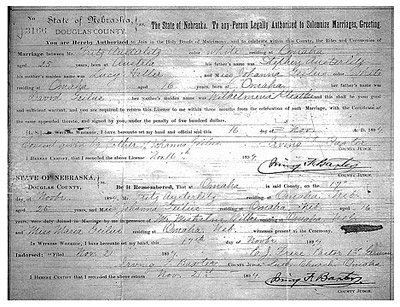 |
*A copy of the marriage certificate for Fred Astaire's parents, who were married in Omaha in 1894.
After his arrival in New York and a brief stay at Ellis Island,
Fritz Austerlitz made his way west to Omaha, Nebraska. There
he met a woman much younger than he named Johanna (Ann) Geilus.
Johanna had been born in Omaha, but her parents, David Geilus
and Wilhelmina Klaatke, were German-speaking, Lutheran immigrants
from East Prussia and Alsace. The 25-year-old Fritz and 16-year-old
Johanna were married at the First German Lutheran Church in
Omaha on Nov. 17, 1894. On the marriage license the groom is
listed simply as “Fritz Austerlitz.” The bride's
name is recorded as “Johanna Geilus” with the notation
“consent given by father” of the teenage bride.
To support his family, Austerlitz worked as a salesman for the
Storz Brewing Company in Omaha. Although he had originally come
to Omaha to join two fellow Austrians in a business venture,
their plans didn't work out and Fritz was soon in the beer business.
(Fred always liked to say that his father was descended from
a long line of brewers, but that is yet another “family
legend.”) With the arrival of Nebraska dry laws, Austerlitz
had reason to wish the original business proposition had worked
out, but the Storz Brewery managed to survive the dry laws and
national Prohibition by making ice, near beer, and other non-alcoholic
drinks. Storz continued to brew beer long after Fritz's death.
The Omaha brewery remained in business until 1972.
In 1905 Mr. and Mrs. Austerlitz decided that Ann would take
their two talented children to New York and a career in vaudeville.
Herr Austerlitz would remain in Omaha to earn money for the
family while Ann worked to get the children into show business.
In his autobiography, Fred Astaire remarked:
“...this trip was really a stab in the dark. We were going
to New York without so much as a letter of introduction to somebody's
aunt. My mother had never been there, and she knew no one, theatrical
or otherwise. She had not even written ahead to enroll us in
a dancing school. So none of the Astaires could have known what
was in store for them.”
In reality, the family did have a specific recommendation for
a dance school in New York, but what was in store for Adele
and Fred was both early success and failure. After an initial
tour on the New Jersey vaudeville circuit, Fred's father came
out to New York to help move things along and soon helped arrange
a bigger tour. Little Fred, then barely seven years old, along
with nine-year-old Adele and his mother, made his first visit
to Los Angeles, B.H. (“Before Hollywood”) while
on the road as part of a successful dance team on the so-called
Orpheum Circuit. Their tour took them all over the country from
Pennsylvania to California, including a warm reception in Omaha.
 Adele Austerlitz (b. 1896)
Adele Austerlitz (b. 1896)
 Frederick Austerlitz (b.
10/05/1899 Omaha NE, d. Los Angeles 22/06/1987) aka FRED
ASTAIRE, married in 1933 to Phyllis Livingston Potter
(who had a son, Peter, from a previous marriage). Phyllis
Astaire died of cancer in 1955, and in 1980 at age 81, Fred
remarried. His second wife, Robyn Smith, then age 35 and a
former jockey, shared with Fred a life-long interest in horses
Frederick Austerlitz (b.
10/05/1899 Omaha NE, d. Los Angeles 22/06/1987) aka FRED
ASTAIRE, married in 1933 to Phyllis Livingston Potter
(who had a son, Peter, from a previous marriage). Phyllis
Astaire died of cancer in 1955, and in 1980 at age 81, Fred
remarried. His second wife, Robyn Smith, then age 35 and a
former jockey, shared with Fred a life-long interest in horses
 Fred Jr. Astaire (b. 1936)
Fred Jr. Astaire (b. 1936)
 Ava Astaire (b. 1942)
Ava Astaire (b. 1942)
|
“There are two kinds of Austrians—rascals
and musicians—
I, of course, am a musician!”
— Fred Astaire quoting a quip of his
father's
Special thanks to Alessandra Garofalo
in Italy for her important research
and help with Fred Astaire's Austrian background. |
|
Fred claims it was his father's idea to change the dance
team's last name to Astaire. Realizing that the family
name was a tough sell on theater marquees (“Austerlitz
sounded like a battle”), Mr. Austerlitz suggested
borrowing the name of an uncle from Alsace-Lorraine named
L'Astaire. Even though in the early days of their act
Adele was older and taller, the team was billed as Fred
and Adele Astaire. By 1914, despite a few lows along with
highs, brother and sister had become vaudeville pros...
but the big time was still elusive.
Eventually Fred and Adele ended up with stage successes
on Broadway and even in London. The big time had arrived.
In fact, London gave them a bigger welcome than New York,
but it was in London in 1924 that word arrived of their
father's worsening health. Their mother and constant companion
returned to America to be with her ailing husband, and
it was not much later, during the London run of “Stop
Flirting,” that Fred learned of his father's death
in Omaha—an Omaha and a father that were now faint
recollections. He and Adele managed to go on stage that
night and finished the remainder of the one-and-a-half-year
run of “Stop Flirting.” (Their mother would
live to the venerable age of 96. A widow for 51 years,
Ann Geilus Austerlitz succumbed to a stroke in July 1975.
She is buried near her son in Chatsworth, California.)
Fred and his sister returned to New York and enjoyed a
very successful run of a new George Gershwin musical called
“Lady, Be Good!” In 1926 they repeated this
success in the same musical in London. The Astaires were
now stage stars on both sides of the Atlantic. In June
1927 they returned to the US and had more success in musicals.
But Adele was growing tired of show business. In 1932
Adele announced her retirement from the grueling song-and-dance
circuit and her intention to marry Lord Charles Cavendish,
second son of the Duke of Devonshire.
So Fred was on his own, but he would not be alone. He
had met and fallen in love with 25-year-old New York socialite
Phyllis Potter, the former Phyllis Livingston Baker of
Boston. In 1933 they were married (one day after Phyllis'
divorce settlement) and flew off to Hollywood to begin
their life together and Fred's new film career at RKO.
Twenty-six hours later their Ford Tri-Motor touched down
at the Burbank airport... and the rest is history.An Astaire
(Austerlitz) Timeline
• 1892 Friedrich (Fritz) Austerlitz, Fred
Astaire's future father, leaves Austria for the United
States.
• Oct. 26, 1892 According to the ship's manifest,
Fritz Austerlitz, a “clerk” aged 24, arrives
in New York harbor aboard the S.S. Westernland from Antwerp,
Belgium. A few days later he heads for Omaha, Nebraska.
• Nov. 17, 1894 Fritz Austerlitz and Johanna
(Ann) Geilus are married at the First German Lutheran
Church in Omaha.
• Sept. 10, 1896 Adele Austerlitz (later Adele
Astaire) born in Omaha, Nebraska
• May 10, 1899 Frederick Austerlitz (later
Fred Astaire) born in Omaha, Nebraska
• 1904 Ann Austerlitz takes Adele (7) and
Fred (5) to New York by train. The two children are enrolled
for lessons at the Claude Alvienne dance academy.
• 1905 Billed as Fred and Adele Astaire, the
brother and sister act makes its vaudeville debut in Keyport,
N.J.
• Feb. 20, 1922 Fred and Adele Astaire debut
in their first on-stage speaking roles in "For Goodness
Sake" at the Lyric Theater in New York City.
• May 30, 1923 Opening night for the Astaires
in the London production "Stop Flirting" (an
Anglicized version of "For Goodness Sake").
They receive rave reviews.
• 1924 In London, while "Stop Flirting"
is still running, Fred and Adele learn of their father's
death in Omaha.
• 1932 Adele Astaire retires from show business,
marries Lord Charles Cavendish, the first of three husbands
• 1933 Fred Astaire marries Phyllis Potter
and begins his new dancing/musical career in Hollywood.
Fred and Phyllis will have two children, Fred, Jr. and
Ava.
• Sept. 13, 1954 Phyllis Astaire, a longtime
smoker, dies of lung cancer.
• July 1975 Ann Geilus Austerlitz dies of
a stroke aged 96.
• June 24, 1980 Fred Astaire (81) and jockey
Robyn Smith (36) wed in a quiet ceremony at the Astaire
home in Beverly Hills. They had first met at Santa Anita
racetrack in 1973.
• January 1981 Adele Astaire dies of a stroke
in Tucson, Arizona.
• June 22, 1987 Fred Astaire dies of pneumonia
in a Los Angeles hospital with wife Robyn at his side.Fred
Astaire Films
Fred Astaire actually had several different careers. When
he and Adele ended their combined act in 1932, they had
already spent some 28 years in show business. It was then
that Fred headed for Hollywood, Ginger Rogers, and a string
of very successful musical films. His dancing career and
movie musicals in general came to an end by the late 1960s.
Astaire then became known for his dramatic roles in films
such as On the Beach (1959) and The Towering Inferno (1974).
• Dancing Lady (1933, MGM) with Joan Crawford, Clark
Gable
• Flying Down to Rio (1933, RKO) with Ginger Rogers,
Delores Del Rio
• Top Hat (1935) with Ginger Rogers, Edward Everett
Horton
• Follow the Fleet (1936, RKO) with Ginger Rogers,
Betty Grable, Randolph Scott, Lucille Ball
• Swing Time (1936, RKO) with Ginger Rogers, Victor
Moore, Betty Furness
• Shall We Dance? (1937, RKO) with Ginger Rogers,
Edward Everett Horton
• Silk Stockings (1957) with Peter Lorre, Cyd Charisse;
a musical "Ninotchka."
• On the Beach (1959) - An atomic disaster drama
with Ava Gardner, Gregory Peck. Directed by Stanley Kramer.
• The Pleasure of His Company (1961) with Debbie
Reynolds, Lilli Palmer, Tab Hunter
• The Notorious Landlady (1962) with Kim Novak,
Jack Lemmon
• The Towering Inferno (1975) with Steve McQueen,
Paul Newman, William Holden
• Ghost Story (1981) with Melvyn Douglas, Douglas
Fairbanks, Jr., John Houseman
Fred Astaire Links
• Fred Astaire at IMDb with a complete filmography.
• Classic Movies by Brad Lang at ClassicMovies.org.
An updated Fred Astaire tribute originally written for
his 100th birthday in 1999 - with links to other Astaire
sites.
• Elizabeth's Fred Astaire Page - She also has a
Ginger Rogers and Fred Astaire page.
• Fred Astaire.net - Many Astaire resources
• Fred Astaire at Film100.com - Astaire is number
86 (site no longer online)
• The Dancers: Fred Astaire - Mostly links for Fred
Astaire. - The Golden Years.
• Fred Astaire's gravesite - Oakwood Memorial Park,
Chatsworth, California. Photo from Find-A-Grave.
|
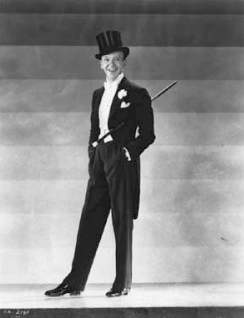 Though
on screen Fred was most often associated with a top hat,
white tie and tails, in real life he detested formal dress
and looked on his signature costume as work clothes. Though
on screen Fred was most often associated with a top hat,
white tie and tails, in real life he detested formal dress
and looked on his signature costume as work clothes.
FREDERICK AUSTERLITZ was born on May
10, 1899 in Omaha, Nebraska to Frederic E. Austerlitz,
an Austrian immigrant and traveling salesman, and his
wife Ann Geilus Austerlitz. His sister Adele, older by
eighteen months, showed a talent for dancing at an early
age, and although only four years old, young Fred accompanied
his sister to ballet school. In 1904, Mrs. Austerlitz
moved with the children to New York where they were enrolled
in a performing arts school run by Ned Wayburn, one of
the pioneers of modern tap dancing. The following year
Fred and Adele made their vaudeville debut on a stage
in New Jersey as a miniature bride and groom, and began
touring on the Orpheum circuit in an act called "Juvenile
Artists Presenting an Electric Musical Toe-Dancing Novelty."
Though Fred sporadically attended public school in New
Jersey, most of his schooling came on the road under his
mother's tutelage.
With the advent of World War I, the Austerlitz's anglicized
their name to "Astaire" and the teenage brother-sister
hoofers began to make the new name famous. In 1917 the
pair made their Broadway debut in a musical revue called
"Over the Top," and although the show itself
didn't fare well, the Astaires received very positive
notices. Though they seldom had any lines, Fred and Adele
danced their way through a number of musical revues until
in 1922 they were cast in "For Goodness' Sake"
with songs by George and Ira Gershwin. Although they had
sixth billing, they stole the show.
Throughout the 1920s, the Astaires danced their way to
stardom by way of such triumphs as "Funny Face,"
"Lady, Be Good!" and "The Band Wagon."
However in 1932, Adele retired from show business to marry
Lord Charles Cavendish, and Fred was left to fend for
himself. Because his sister was usually regarded as the
better dancer of the two, and the plots of most of their
shows together accommodated the fact that they were siblings
in real life, Fred was not regarded as a much of a romantic
leading man. In 1932 however, he struck out on his own
with a new partner, Claire Luce, starring in Cole Porter's
comedy musical "The Gay Divorce" in which he
introduced the song "Night and Day." "The
Gay Divorce" would be Fred's last stage musical.
That same year, anxious to escape his reputation as Adele's
brother, Fred made a screen test for RKO and was signed
by studio head David O. Selznick despite doubts about
his physical appearance and acting ability. Because RKO
had no projects ready for him, Fred made his film debut
on loan-out to MGM in DANCING LADY (1933) with Joan Crawford
and Clark Gable. He had one number. Still without work
at RKO, Fred went to London to tour with "The Gay
Divorce." When he returned, he was cast as an accordion
player in a musical love-triangle story starring Gene
Raymond, Dolores Del Rio and Raul Roulien called FLYING
DOWN TO RIO (1933). His female counterpart in the film
was an up-and-coming RKO contract player named Ginger
Rogers, and after their one dance number together stole
the picture from the three stars, Fred and Ginger became
the silver screen's most popular dancing duo.
Astaire with composer Irving Berlin who contributed songs
to six of Fred's films including TOP HAT (1935) and EASTER
PARADE (1948).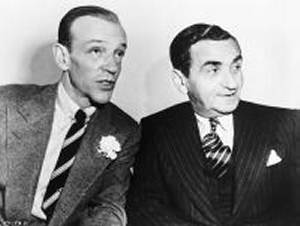
Astaire and Rogers made a total of nine
musicals together at RKO between 1933 and 1939, and though
Ginger made several other comedies and solo musicals between
her films with Fred, Astaire made only one film without
Rogers -- DAMSEL IN DISTRESS (1937) with Joan Fontaine.
It was the only film of his career to lose money at the
box-office. More than just a dancer in his films with
Rogers, Astaire proved himself an accomplished choreographer.
With the help of RKO dance director Hermes Pan, he spent
months experimenting with new moves and developing fresh
routines for the films. The easygoing air that became
his trademark both in his tap solos and tap/ballroom numbers
with Rogers resulted from hours of painstaking work. Astaire
was frequently described as a perfectionist, and Adele
had even nick-named him "Moaning Minnie" for
his workaholic ways.
The results spoke for themselves however, and Fred and
Ginger's musicals were some of the biggest money-makers
of the Great Depression. As their first starring vehicle,
RKO adapted "The Gay Divorce" (retitled THE
GAY DIVORCEE (1934)) which proved a huge success. And
though the pair was second-billed behind Irene Dunne in
ROBERTA (1935), for TOP HAT (1935) and subsequent films
including FOLLOW THE FLEET (1935), SWING TIME (1936) and
SHALL WE DANCE (1937), they appeared above the title.
By the time THE STORY OF VERNON AND IRENE CASTLE was released
in 1939, Fred and Ginger's popularity had waned and both
decided to go their separate ways. Fred was wary of the
possible repercussions of being again known only as part
of a pair, and Ginger was anxious to try her hand at more
serious dramatic acting.
His contract at RKO having run out, Fred spent the next
several years free-lancing at various studios, dancing
with a variety of new partners. Though BROADWAY MELODY
OF 1940 with Eleanor Powell received mixed reviews, YOU'LL
NEVER GET RICH (1941) and YOU WERE NEVER LOVELIER (1942)
helped rocket Columbia starlet Rita Hayworth to stardom.
However, after the lackluster box-office performance of
YOLANDA AND THE THIEF (1945) with Lucille Bremer and BLUE
SKIES (1946) with Bing Crosby, Fred announced his retirement
from motion pictures and began to concentrate on opening
a chain of Fred Astaire Dance Studios around the country.
Astaire and son Fred Jr. on the cover of the August 25,
1941 issue of LIFE Magazine.
 |
Fred's retirement was short-lived however.
When Gene Kelly broke an ankle playing touch football
and was unable to make EASTER PARADE (1948) with Judy
Garland and Ann Miller, MGM asked Fred to fill in. He
did, and the film's success lead to a contract with Arthur
Freed's musical unit at MGM and a decade more of Astaire
films. The following year he was reunited with Ginger
Rogers for their tenth and final musical, THE BARKLEYS
OF BROADWAY (1949). During this second phase of Astaire's
film career, though the quality of plots and songs varied,
Fred continued to develop inventive dance routines. In
ROYAL WEDDING (1951) with Jane Powell, he danced one number
with a coat-rack and a second on the walls and ceiling
of a hotel room. Other notable partners from this period
included Cyd Charisse (THE BAND WAGON (1953) and SILK
STOCKINGS (1957)), Vera-Ellen (THREE LITTLE WORDS (1950)
and THE BELLE OF NEW YORK (1952)), and Audrey Hepburn
(FUNNY FACE (1957)).
In March 1950, Ginger Rogers presented Fred with an honorary
Oscar on behalf of the Academy of Motion Picture Arts
and Sciences for "his unique artistry and his contributions
to the technique of musical pictures." In 1959, Fred
made his dramatic film debut in ON THE BEACH, and though
he made one more musical, the unsuccessful FINIAN'S RAINBOW
(1968) with Petula Clark, the remainder of his films showcased
Fred as an actor. Most notable among these later pictures
were THE PLEASURE OF HIS COMPANY (1961) with Debbie Reynolds
and THE TOWERING INFERNO (1974) for which he received
a Best Supporting Actor nomination. Fred also kept busy
in television, appearing in his own special, "An
Evening with Fred Astaire" which earned nine Emmy
awards, and in 1959 he published an autobiography entitled
Steps in Time.
Astaire stopped dancing professionally about 1970 when
he was already over 70 years old, explaining that his
age restricted his ability to perform at a level acceptable
to him. He continued to make appearances however, and
in 1976 teamed with Gene Kelly to host THAT'S ENTERTAINMENT!
II, a sequel compilation of film clips from the great
MGM musicals. In 1973, Fred was honored by the Film Society
of Lincoln Center in a two-and-a-half hour gala featuring
40 dance excerpts from his films which he picked himself.
In 1981, the American Film Institute presented him with
its ninth Life Achievement Award.
Married to Phyllis Livingston Potter (who had a son, Peter,
from a previous marriage) in 1933, Astaire had two children:
Fred Jr., born in 1936, and daughter Ava, born in 1942.
Phyllis Astaire died of cancer in 1955, and in 1980 at
age 81, Fred remarried. His second wife, Robyn Smith,
then age 35 and a former jockey, shared with Fred a life-long
interest in horses. Fred had been a stable owner and avid
horse-racing fan for over 30 years. Astaire made his final
film appearance in GHOST STORY (1981) and died of pneumonia
in Los Angeles, California on June 22, 1987 at the age
of 88. |
| 100 years of Fred
Astaire
Astaire, a day before his 85th birthday
May 14, 1999
From Sherri Sylvester
CNN Entertainment News Correspondent
LOS ANGELES (CNN) -- Fred Astaire was born a century ago
this week.
And although he died in 1987, his legacy of elegance,
grace and ingenuity on the dance floor has not faded.
Looking at almost any of some 40 films, it's hard not
to repeat the cliche, "He made it look so easy."
But Astaire worked hard to become a sensation, starting
at an early age.
He was born Frederick Austerlitz, the son of an Austrian-immigrant
beer salesman, on May 10, 1899 in Omaha, Nebraska. His
mother enrolled him in dancing school in New York at the
age of 4, with his sister Adele who was 6.
No more than a year after they began dance classes, they
made their professional debut in Keyport, New Jersey,
as The Astaires. Their mother suggested the name change
because she felt Austerlitz sounded like a battle. Astaire
was Fred's paternal grandmother's maiden name. Their kiddie-dance
act earned high praise, and by the time Fred was 7, the
brother-sister duo was touring on the vaudeville circuit.
Within some five years, Fred's lankiness was making it
hard for the brother and sister to dance together -- he
needed time to catch up to the adolescent Adele. So they
took a break from the stage and studied with showman Aurelia
Coccia. When they returned to the limelight, they were
better than ever.
They left vaudeville and worked for some 15 years on Broadway
and in London's West End. While hobnobbing with royalty
in England, Adele met Lord Charles Cavendish, Devonshire.
They married in 1932, and she left show business.
The Astaires suddenly was a solo act -- one Astaire, Fred.Fred
and sister Adele Astaire rehearsing George Gershwin's
"Fascinating Rhythm" in the 1924 Broadway musical
"Lady Be Good"
Hollywood boundHe fell in love with New York socialite
Phyllis Potter, married -- and began testing for film
work. After seeing one test, a Universal producer issued
an ultimately entertaining verdict: "Can't act, can't
sing, slightly balding, can dance a little." Despite
that less-than-flattering review, Astaire landed a small
part opposite Joan Crawford in the 1933 film "Dancing
Lady."
In his second film, "Flying Down to Rio" (1933),
he was paired with Ginger Rogers. Their on-screen chemistry
was so good that they were paired on a total 10 pictures,
including "The Gay Divorcee" (1934), "Top
Hat" (1935), "Swing Time" (1936) and "Shall
We Dance?" (1937).
The dance of the trophiesAstaire raked in the awards.
He was voted Money-Making Star in the Motion Picture Herald
Fame Polls for three consecutive years, from 1935 to 1937.
By 1949, he'd won an honorary Academy Award for "raising
the standards of all musicals." In just two years,
1958 and 1959, he won nine Emmys. And that, after trying
to go into retirement more than a decade earlier, in 1946.
An injury scuttled that bow-out -- Gene Kelly's injury.
In 1948, dancing colleague Kelly was injured while rehearsing
"Easter Parade" with Judy Garland. Astaire stood
in for Kelly in what turned out to be one of his most
enduring films. Its big numbers include "Drum Crazy,"
"Better Luck Next Time" and the speed-demon
work of Ann Miller in "Shakin' the Blues Away."
Astaire went through one of the hardest periods of his
life in the mid-'50s. His wife Phyllis died of cancer,
as he filmed "Daddy Long Legs" (1955). They'd
been married for 21 years and had two children, Fred Jr.
and Ava. Still his career flourished, as he appeared in
such films as "Funny Face" and "Silk Stockings,"
both in 1957. In the 1959 "On the Beach," based
on Nevil Shute's bleak novel about nuclear holocaust in
Australia, Astaire proved his mettle in dramatic work.
He'd later be nominated for a best-supporting-actor Oscar
in "The Towering Inferno" (1974).
THE FRED ASTAIRE/GINGER ROGERS FILMS
"The Barkleys of Broadway" (1949)
"Carefree" (1938)
"Flying Down to Rio" (1933)
"Follow the Fleet" (1936)
"The Gay Divorcee" (1934)
"Roberta" (1935)
"Shall We Dance?" (1937)
"The Story of Vernon and Irene Castle" (1939)
"Swing Time" (1936)
"Top Hat" (1935)
A new loveAstaire met Robyn Smith at the racetrack on
New Year's Day 1973. She was one of the most successful
female jockeys in the world. They married in 1980. Smith
was 35. Astaire was 81.
"When we married I never thought of age because he
was so young acting," Robyn Astaire says. "And
to watch his old movies now, as some many people do --
he's just ageless."
As if to prove that point, the Academy of Motion Picture
Arts and Sciences honored Astaire with a Lifetime Achievement
award in 1981.
The Astaires spent their time together in the comforts
of retirement. But after less than a decade of marriage
to Robyn, Fred died of complications from pneumonia on
June 22, 1987, at age 88.
Protecting the legacyRobyn Astaire today fights to protect
her husband's image. She initiated United States Senate
Bill 209, which would further protect heirs against the
unlicensed marketing of dead celebrities.
"They're putting him on coffee mugs and pencils,
and I put a stop to all of that .... That's the reason
I initiated this bill ... so other people could have some
control over the use of their image."
With all of Fred Astaire's contributions to the movie
musicals, Robyn Astaire says the just thing to do is to
leave his legendary mark untouched.
RELATED STORY:
If you knew Emmys like we knew Emmys
September 4, 1998
RELATED SITES:
The Kennedy Center Honors: Fred Astaire
Fred Astaire: Memories of a time gone by
Note: Pages will open in a new browser window
External sites are not endorsed by CNN Interactive.
http://www.cnn.com/SHOWBIZ/Music/9905/14/fred.astaire/ |
|
Biography
 The
name Fred Astaire has become synonymous with great dancing.
Though the times have changed and dancing along with them,
dancers everywhere still look to Fred Astaire as a major
influence. Watching his films, it is not hard to
see why. He flew through the air with grace and
made even the most complicated steps look easy. The
name Fred Astaire has become synonymous with great dancing.
Though the times have changed and dancing along with them,
dancers everywhere still look to Fred Astaire as a major
influence. Watching his films, it is not hard to
see why. He flew through the air with grace and
made even the most complicated steps look easy.
Fred Astaire, was born Frederick Austerlitz on May 10,
1899 in Omaha, Nebraska. His father, an Austrian
emigre, had made quite a success as a beer salesman and
had married the charming and beautiful Ann Gelius.
From the beginning the young couple surrounded Fred and
his older sister Adele with music. Adele was the
first to be hit by the "showbiz bug".
When she was six years old she was signed up for dance
classes and, although at first reluctant, Four-and-a-half
year old "Freddie" would soon be tagging along.
Adele and Freddie learned quickly and soon their parents
began to dream of bigger and better things for their children.
No more than a year after they began dance classes, Fred
and Adele made their debut as the "Astaires".
It was their mother who suggested the name change, she
felt Austerlitz sounded too much like a battle.
Astaire was his paternal grandmother's maiden name.
The Astaires first appeared in a small theater in Keyport,
N.J. They were an instant success. The local
newspaper called them, "...the greatest child act
in Vaudeville." The children began to tour
on the local Vaudeville circuit. The act was hailed
and they were a favorite in every town they came to.
Unfortunately five years later nature took it's course
and Adele began to blossom and grow. Freddie, however,
was still a lanky boy. Dancing together became,
for the time, impossible. So, the Astaires were
forced into hiatus while they waited for Fred to :"catch
up" to Adele.
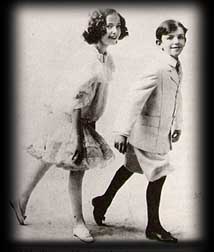
It wasn't long before the two were back
out on the circuit entertaining again. The act had
grown as well. During their break they were privilleged
to have been under the tutilege of an expert showman name
Aurelia Coccia. They were even greater than before.
So great, in fact, that they had outgrown the Vaudeville
circuit. beckoned them. They were spotted
by several producers and enjoyed a very successful carreer
both on Broadway and in London. They were the toast
of both the towns. It was in London that Adele met
and was courted by Lord Cavendish, the second son of the
Duke of Devonshire. In 1932 she married Lord Cavendish
and quit the stage to begin a family. The
Astaires were no more.
Fred was not about to give up. The road ahead was
going to be rough and he knew it. However, he would
not have to go through it alone. In New York he
had met a pretty young socialite named Phyllis Potter.
The two soon fell in love and were married. It was
at this time that Fred had begun to test for motion pictures.
It was after one of these tests at Universal that
a producer gave him this now famous verdict: "Can't
act, can't sing, balding, Can dance a little".
Nevertheless, Fred was signed to a movie contract.
In his second film, "Flying Down to Rio" he
was teamed up with another Hollywood newcomer named Ginger
Rogers. The two hit the screen like lightning and
ignited an exciting string of hits including, "The
Gay Divorce," "Roberta," "Top Hat,"
"Follow the Fleet," "Swing Time,"
"Shall We Dance?," "Carefree," and
"The Story of Vernon and Irene Castle".
It is these films films that fans look back on as the
best years of his career. There was something about
his partnership with Rogers that was magical. He
stared with a number of wonderful leading ladies in his
carreer including, Rita Haywork, Cyd Charisse, Judy Garland,
and Leslie Caron. But it is his numbers with Rogers
that we all remember. Katherine Hepburn said it
best when she explained why the team was so well matched,
"Astaire gave her class; Rogers gave him sex."
.
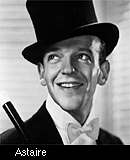
Fred enjoyed a very succesful movie carreer
for several years starring in some of Hollywood's most
unforgetable movies. But it seems as though all
good things must come to an end. In 1946 after filming
"Blue Skies" he announced to the world his retirement.
However, this retirement was short lived. In 1948
his colleague and good friend Gene Kelly injured himself
while rehearsing for a film to be called "Easter
Parade". Fred stepped in to star opposite Judy
Garland in what would be one of his most memorable films
ever. Easter Parade was a hit and Fred was back.
Like it or not the silver screen called to him and he
would not leave it again.
Astaire completed several more memorable films incluiding
"Daddy Long Legs" in 1954. It was during
the filming of this film that his beloved wife Phylis
died of cancer. Fred was crushed. He and
his wife had been very much in love and for the rest of
his life he could not talk of her death without wincing.
His carreer, however, could not have been better.
Fred continued to dance in movies, and also broadened
his horizons to the fastly expanding medium of television.
He was immensley successful on the small screen especially
in a series of shows he did with his new dancing partner
Barrie Chase.
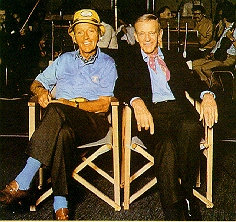 Fred enjoyed a wide range of success
all throughout the 60s and 70s. In 1974 he was nominated
for an Academy Award for Best Supporting Actor for his
role in "The Towering Inferno".
He also teamed up again with his friend Gene Kelly in
1978 for the tremendously successful "That's Entertainment
Part 2". That same year he was honored as
a recipient of the Kennedy Center Honors. It was
during these years that Fred had begun a relationship
with a young female jockey named Robyn Smith. The
much younger Smith had been enjoying a very successful
carreer as a jockey when she met Fred. The two fell
in love and in 1980 they married. Fred enjoyed a wide range of success
all throughout the 60s and 70s. In 1974 he was nominated
for an Academy Award for Best Supporting Actor for his
role in "The Towering Inferno".
He also teamed up again with his friend Gene Kelly in
1978 for the tremendously successful "That's Entertainment
Part 2". That same year he was honored as
a recipient of the Kennedy Center Honors. It was
during these years that Fred had begun a relationship
with a young female jockey named Robyn Smith. The
much younger Smith had been enjoying a very successful
carreer as a jockey when she met Fred. The two fell
in love and in 1980 they married.
The two enjoyed a very happy life together full of the
comforts of retirement. In 1981 Fred Astaire was
honored by the Academy of Motion Picture Arts and Sciences
with the prestigious Lifetime Achievment Award. He lived
out the rest of his life enjoying his marriage to Robyn.
The two were very happy together and shared many wonderful
times.
Fred enjoyed a full life, a life that few really get.
So it was with a heavy heart and fond farewell that Fred
left us on June 22, 1987. He died of complications
from pneumonia in the arms of his wife. He left
behind two children and one of thousand memories of a
carreer not yet paralleled by another. Fred Astaire
was the embodiment of class and style. He is a reminder
of a time too often forgotten in this modern era.
In the words of Mikhail Baryshnikov, "He will be
a never-ending legend."
Special thanks to Brad Darrach for his wonderful article
"He Made us Feel Like Dancing" from which much
of the above information is obtained.
|
|